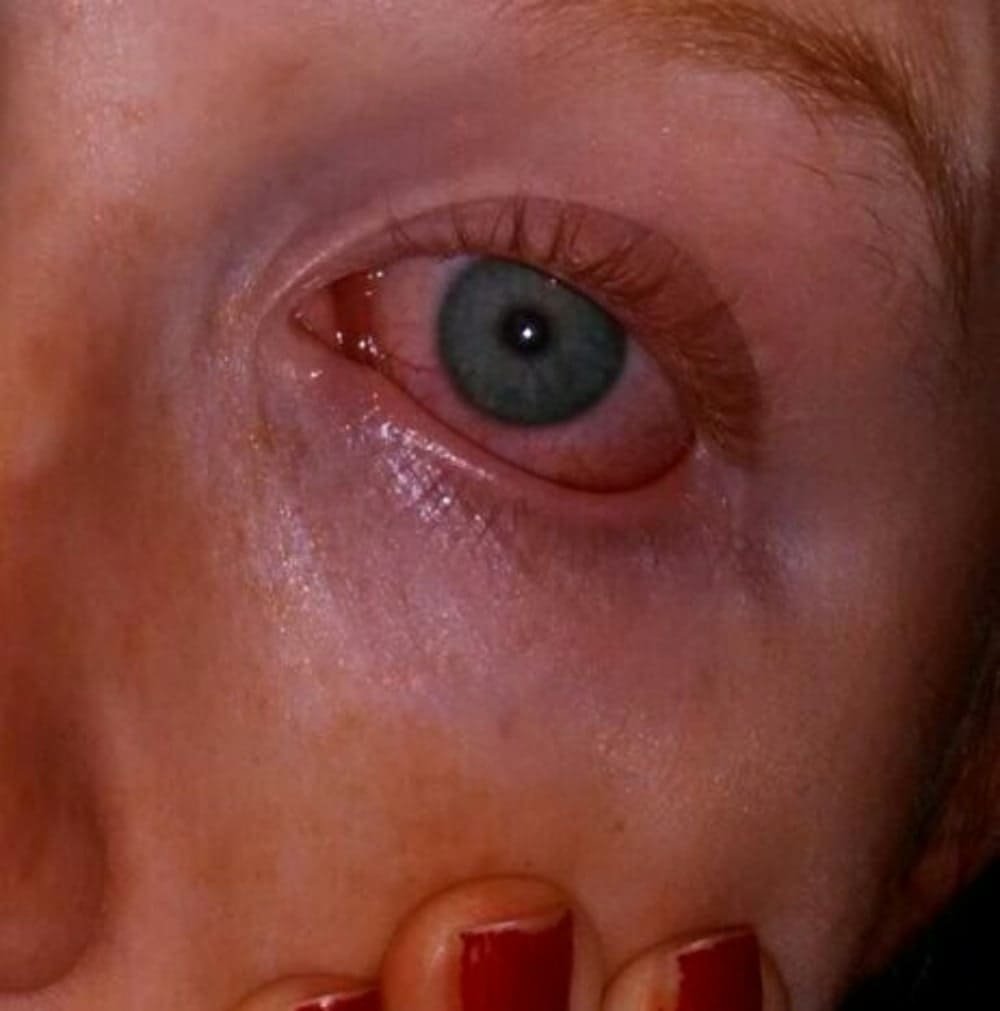
Dry eye syndrome can be pretty uncomfortable.
It can even cause blurry vision and make driving at night difficult.
So if you’re addicted to video games, surfing the web, or watching TV, stay tuned for more information on the causes and treatment of this syndrome.
Dry eyes cause
Dry eye syndrome is a common condition where tears can’t provide adequate lubrication for the eyes.
Hence, the main reason is not producing enough tears.
There are several causes of dry eyes syndrome, for example;
Vitamin A deficiency
Vitamin A enhances eye health, so an unbalanced diet lacking vitamin A leads to dry eye and vision impairments.
Several foods are rich in vitamin A, such as;
- Spinach.
- Broccoli.
- Carrots.
- Eggs.
- Pepper.
- Fish.
Laser surgeries
Some people suffer from dry eyes after LASIK surgery (laser vision correction).
This surgery causes damage to some corneal nerves, resulting in a decrease in tear production.
This type of eye dryness is temporary.
It usually improves after a few days or weeks of using artificial lubricating tears to help the eyes heal.
Hormones
Hormones have a significant role in eye dryness.
Some women suffer from dry eye syndrome during pregnancy, postmenopause, or while using contraceptive pills.
Blepharitis
Blepharitis occurs when the tiny oil glands near the base of eyelashes in the inner eyelid become clogged and inflamed, leading to dry eyes disease.
Eye allergies
Dry eyes caused by allergies may eventually turn into a chronic condition.
Although antihistamines can help with allergies, they can also aggravate eye dryness.
Examples of allergens include; pollen grains and other natural irritants.
Autoimmune diseases
Many autoimmune diseases lead to poor tear production, and diagnosis of these diseases may help improve symptoms of this syndrome.
Autoimmune diseases include:
- Sjogren’s syndrome.
- Lupus.
- Rheumatoid arthritis.
- Thyroid disorders.
- Type-1 diabetes mellitus.
Certain medications
Some medications reduce mucus production and lead to dry eye syndrome, such as:
- Antidepressants.
- Diuretics.
- Beta-blockers.
- Some acne medications.
- Decongestants.
Other factors that cause dry eyes syndrome include:
- Exposure to the wind.
- Eyelid problems: the eyelid turning outward or inward.
- Dry air.
- Smoke.
- Using computers.
- Contact lenses
Dry eye disease risk factors
Some factors increase the risk of dry eyes, such as:
- A diet deficient in vitamin A or omega-3 fatty acids.
- Contact lenses.
- Aging; dry eye syndrome is common among people above 50 years old.
- Hormonal changes in women.
Symptoms of dry eye syndrome
Common symptoms include;
- Eye redness.
- Light sensitivity.
- Burning or scratchy sensation in the eye.
- A feeling of having something stuck in the eye.
- Difficulty in nighttime driving.
- Having difficulty wearing contact lenses.
- Blurred vision.
- Eye fatigue.
- A viscous fluid in the eye.
Dry eye syndrome complications
People who have dry eyes may experience these complications:
- Eye infection.
- Eye damage: If left untreated, severe eye dryness may lead to eye inflammation, abrasion of the corneal surface, corneal ulcer, and vision loss.
- Difficulty while performing everyday activities, such as reading.
Can dry eyes cause a headache?

Dry eyes are often accompanied by; a headache or a migraine.
But there is no rationale to justify the connection between the two, particularly migraines.
Researchers discovered, however, that people who suffer from migraines have a different visual structure than others.
Moreover, dry eyes are common in migraine patients.
Further studies are needed to assess the relationship between dry eyes and migraines.
Dry eyes and double vision
Dry eyes are the main reason for double vision, especially monocular double vision, which may occur in one or both eyes.
Double vision is; a condition where the eyes do not produce enough tears, or the tears dry out of the eyes rapidly.
Dry eye syndrome diagnosis
Medical examinations for diagnosis include:
A comprehensive eye exam
Eye examination and the patient’s medical history help the opthalmologist determine the main dry eyes cause.
Measuring the volume of the tears
The doctor measures the tears’ volume using paper strips placed under the lower eyelids.
After five minutes, the doctor measures the amount of absorbed tears.
This test is known as Schirmer Test.
A tears’ quality test
Ophthalmologists use special dyes in eye drops to evaluate the eye surface condition.
This test shows the staining patterns of the cornea and measures how long it takes before the tears evaporate.
Tear osmolarity test
This test determines the particle and water content of tears.
The amount of water in tears is reduced in people who suffer from dry eyes syndrome.
Tear samples
Samples are taken to look for dry eye signs.
Treatment
It depends on many factors:
- If the dry eyes disease is due to a medical condition, the patient must take proper medication to control or reduce the symptoms of this condition.
- But, if it is due to using certain medications, the patient should contact the doctor to replace the dry eye-induced medication.
The treatment methods include:
Artificial tears
Artificial tears are common medications for dry eyes since they help in eye lubrication.
Doctors prescribe them for mild conditions of dry eye syndrome.
Anti-inflammatories
These medications help control corneal inflammation and reduce the risk of corneal damage.
They also increase eye tears.
Anti-inflammatory eye drops include:
- Cyclosporins (Restasis).
- Corticosteroids.
They are used for short-term treatment in severe conditions; to reduce side effects.
Tear stimulating drugs
These medications help increase tears production, such as:
- Pilocarpine.
- Cevimeline.
Tears-stimulating drugs are available as pills, eye gels, or eye drops.
Antibiotics
The doctor may prescribe antibiotics when there is an inflammation of the eyelid, which may cause dry eyes.
In this case, the patient takes oral antibiotics, eye drops, or eye ointment.
Punctal plugs
The doctor uses these tiny silicone plugs to stop tears from the rapid drain and keep them inside the eye.
These plugs are removable.
Surgery
Doctors may resort to surgeries when the dry eye syndrome is severe and not treated with medications.
The surgery refers to wholly or partially blocking the tear duct opening at the inner corners of the eye; to maintain an adequate supply of tears.
Prevention methods
Some methods help alleviate dry eyes, for example:
- Use an air humidifier
- Avoid direct air blowing in the eye.
- Quit smoking and avoid smoking areas.
- Take eye breaks during long tasks.
- Wear eyeglasses to block wind and dry air.
- Position the computer screen below eye level.
- Use artificial tears regularly.
In conclusion, there are many causes of dry eyes syndrome.
However, if you follow the prevention methods and take the appropriate medications under the supervision of a doctor, you can control this condition.
Read Also;
Dark eye circles| causes and treatment for adults and children